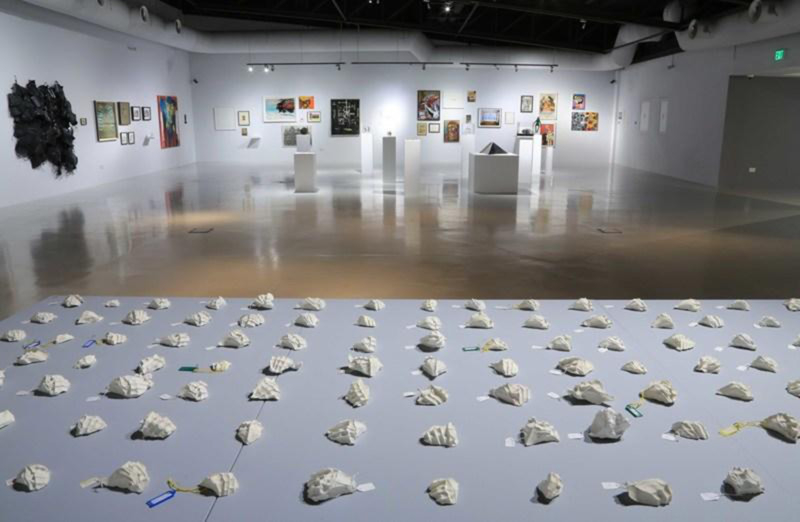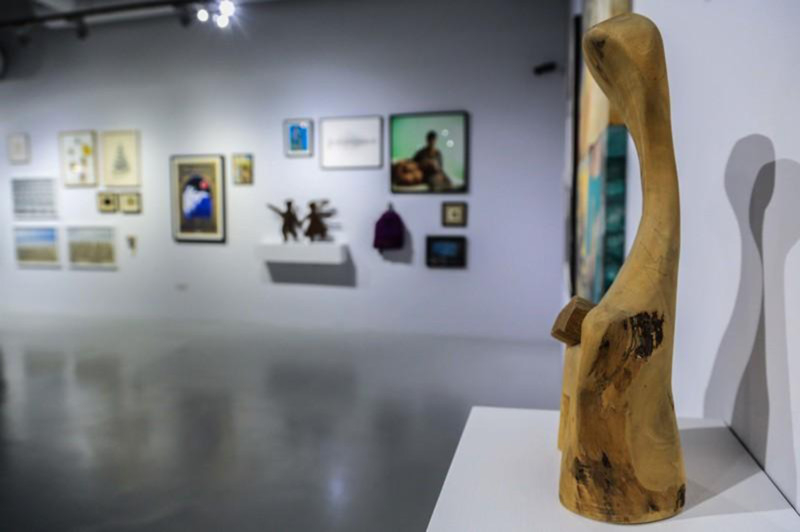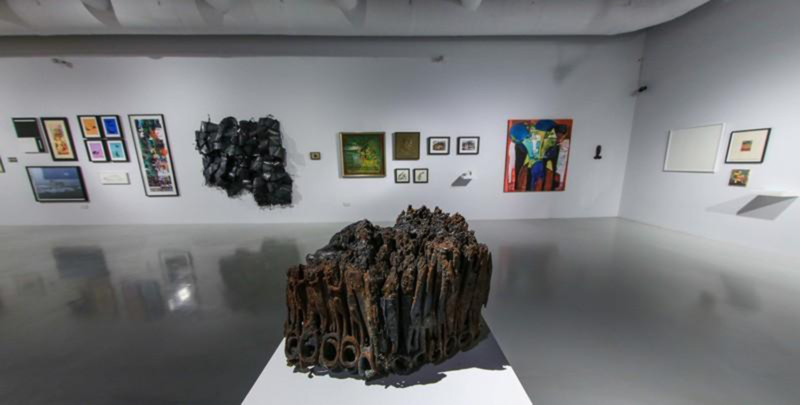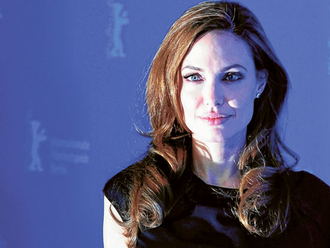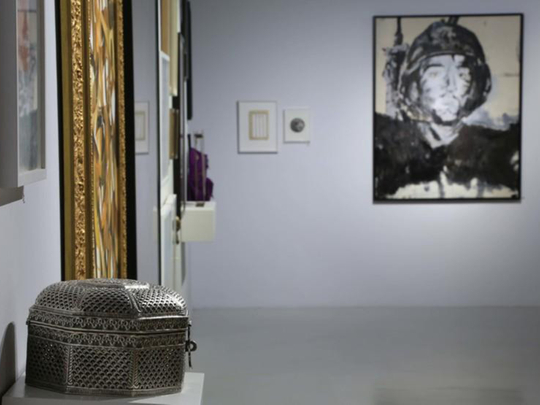
The latest exhibition at Maraya Art Centre, titled Collectivity, explores the collective aspect of the creative process and the formal and informal relationships that make up the art world. It moves the spotlight from artists to the people who work closely with artists, helping them to refine and execute their ideas, produce and exhibit their work, and interpret it for the public.
To trace the collaborative relationships within the art world in the UAE, curator Laura Metzler invited people working in the arts industry across the country to lend an artwork or art-related object from their personal collection, along with a small text explaining how and why they acquired it. The show features works loaned by 84 participants representing every sector of the art world, including commercial galleries, nonprofit foundations, art fairs, universities, museums, art consultancies, art publications, framers and freelance curators and writers. While some have chosen works that inspire them, or resonate with their own thoughts and feelings, others have selected pieces that mean a lot to them because of their connection to artists and projects they have worked with, people they care for, or places they have been to.
In addition to works bought by the participants from exhibitions, fairs and auctions, the show also includes valuable paintings and sculptures gifted to them by artists they have worked with; historic pieces inherited by them; works created by their students; mementos of exhibitions they have been involved in; objects they bought from flea markets; and handwritten notes they exchanged with their colleagues in the art world.
Each object is significant because of the deep personal connection the owner has with it, and the insights it offers into the relationships within the art world. Each work and its reason for being in the show is unique but together the artworks tell us about the networks that exist within the UAE’s diverse and dynamic art community.
The genius of creation
“Our understanding of the art world is generally connected to a fascination with the genius of creation or the movement of finances and willingness to invest in such abstract entities. But instead of artists and collectors, who are at either end of an exchange of ideas and money, we wanted to look at everything that makes this exchange happen and fills in the route between them,” Metzler says.
“So, I only contacted people whose involvement in the industry infrastructure goes beyond being an artist or a collector to see how the people involved in the labour practices relate to artists and their work. The title, Collectivity, refers to the concept of art as a collective activity, the notion of building a collection, and the idea of individuals coming together as a group. The exhibition blends these three notions together, bringing objects from different collections into one space, with the accompanying texts activating them as social indices that map an intricate network of constantly changing personal relationships, which complicate and enrich our understanding of what goes into making art,” she adds.
The work Metzler has contributed from her own collection is an archival film poster gifted to her by artist Zena Al Khalil, with whom she worked as a studio assistant in her first paid job in the art world. “I helped get things ready and make everything easier for her to be productive in the studio, and worked on presentations and projects for the business side of the creative process. I enjoyed being involved in an artist’s practice, and this poster reminds me of one of the foundational experiences of my professional career,” she says.
Pierre Depaz, a digital arts professor at NYU Abu Dhabi chose a USB flash drive carrying five projects submitted by his students. “I participate daily in the process of becoming an artist as I watch my students mature and find their artistic voices. The projects on this flash drive stand both at the end of a trajectory, and at the beginning of a new one, as the conclusion of an exercise that was meant to help them polish their expression, and as their first step towards a fully-realised artistic identity and production. This digital, invisible storage, represents the many invisible steps that art students take as they grow throughout life, leaving only digital, ephemeral copies of who they were at each work,” he says.
Huda Alkhamis Kanoo, founder of ADMAF selected a painting of a traditional doorway by Abdul Qader Al Rais, because it has a special meaning for her. “This painting, bought in 1990, when I was working at the Cultural Foundation in Abu Dhabi, was my first purchase of an artwork by an Emirati artist. I saw something in that doorway that indicated to me a new chapter, a new beginning, and a new direction. This was when I began thinking about an entity that could help develop people’s creativity and society’s interest in the arts, and six years later, the Abu Dhabi Music & Arts Foundation was established,” she says
Antonia Carver, director of Art Jameel, has chosen a sculpture created by her father Michael, which represents her early connection with art, and perhaps her motivation to work in the art world. Christine Dal Bello, public affairs officer at the US Consulate General, Dubai decided to lend a painting by her nine-year-old daughter, created during a course run by the Jam Jar Art Space in Dubai because it represents her family’s increased engagement with the art world since moving to the UAE.
The metal sculpture loaned by freelance curator and writer Laura Egerton, was part of an installation by Nadim Karam, that she and her husband helped him to install during the first edition of Art Dubai in 2007. It is tinged with memories of her excitement of arriving in Dubai, and of the start of her long friendship with the artist.
Batool Mohammed, project coordinator at the Sharjah Art Foundation, has shared a wall label she kept from an exhibition she coordinated, which she cherishes as a memory of a show she loved. And, gallerist Umer Butt has contributed an invitation he sent to Hetal Pawani for his first show at Grey Noise in Lahore, because she kept it and when he moved the gallery to Dubai they became business partners.
Art spaces in the city
Pawani has shared a set of all the ArtMaps she has worked on since she founded ArtintheCity in 2007. The maps, produced with support from Dubai Culture and the arts community, show all the art spaces and art events in the city, providing a historical perspective of Dubai’s art scene over the last two decades.
My own contribution is a small painting by Dubai-based Zambian artist Victor Sitali that I bought at his debut solo exhibition last year. I have been writing about the UAE’s art scene for two decades and have seen numerous pathbreaking exhibitions, followed the trajectory of many amazing artists and acquired works that I truly love. But following Sitali’s artistic journey has been special because he is a homegrown talent who has overcome many challenges to pursue his passion for art.
I first met Sitali, who is hearing impaired, at the Mawaheb art studio for adults with special needs. I was impressed by his work, and his confidence as he explained his ideas to me in sign language. Since then I have watched him grow as an artist, participate in group exhibitions and have his first solo show in Dubai.
I believe his work belongs in this show because of the support he has had from the community — from people such as artist Gulshan Kavarana, who spotted his talent early and became his mentor; Mawaheb studio, which organised residencies for him with a well-known artist in England, and encouraged him to do a course in graphic designing; a volunteer who attended all his classes with him as his sign language interpreter, and collectors who are willing to invest in an unknown artist. To me, his portrait of a strong and beautiful African woman reflects Sitali’s own spirit and resilience, and the UAE’s supportive, nurturing, art community.
Collectivity will run at Maraya Art Centre, Sharjah until August 19.



